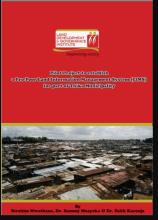Land Library
Welcome to the Land Portal Library. Explore our vast collection of open-access resources (over 74,000) including reports, journal articles, research papers, peer-reviewed publications, legal documents, videos and much more.
/ library resources
Showing items 64 through 72 of 145.According to 2001 statistics, 924 million people, almost one third of the world’s population lived in slums. A majority of these people are in the developing countries and they account for 43% of the urban population.
Fiscal instruments are tools that governments use to manage revenue and expenditure and therefore influence the growth (or stability) of the various sectors of the economy. Government revenue is derived primarily through taxation.
Land plays a vital and central role in the economic, social-cultural and political lives of both individuals and communities.
As governments, the private sector, multilateral institutions, and international development organisations weigh the options for improving food security around the world, they must consider one of the most promising elements for addressing the needs of the world’s hungry and malnourished: secure
Climate change is increasingly being recognised as a global crisis, but responses to it have so far been overly focused on scientific and economic solutions. How then do we move towards morepeople-centred, gender-aware climate change policies and processes?
Climate change is increasingly being recognised as a global crisis, but responses to it have so far been overly focused on scientific and economic solutions. How then do we move towards more people-centred, gender-aware climate change policies and processes?
This research gives an evaluation of Tana delta with regard to areas that are suitable for rice growing. The study area lies on the Eastern delta area of the Tana river of which 16000 hectares have been earmarked for commercial rice farming.
Despite a history of more than 100 years and the introduction of provisional maps to support land registration, the Kenyan cadastre is largely incomplete. It consists of a patchwork of maps of different positional qualities, which would not be readily integrated to create a nation-wide coverage.






